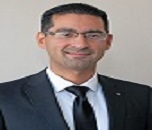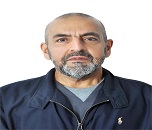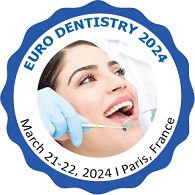Renowned Speakers

Basil Shaikhly
Endodontist , University of Texas A&M school of Dentistry, USA USA

Małgorzata Kotarska
Research Associate Wroclaw Medical University, Poland Poland

Majed Faisal Almuammar
Consultant in Pediatric Dentistry, King Abdulaziz Medical City, Riyadh Saudi Arabia

Jin-Ho Lee
Department of Oral and Maxillofacial Surgery, University of Ulsan Hospital, Ulsan, south Korea South Korea
Recommended Global Dentistry Webinars & Conferences
Europe & UK
Asia Pacific & Middle East
Canada
Euro Dentistry 2024
Welcome Message
Welcome to the 33rd Euro Dentistry Congress, taking place on March 21-22, 2024, in the captivating city of Paris, France. We extend our warm invitation to dental academics, professionals from the dental industry, and all those involved in the dynamic field of dentistry.
Join us for two enlightening days filled with knowledge sharing, networking opportunities, and the latest advancements in dental research and technology. This prestigious event brings together leading experts, researchers, and practitioners from around the globe, offering a platform for fruitful discussions, collaborative partnerships, and valuable insights.
Explore a diverse range of topics, including cutting-edge treatments, innovative techniques, and emerging trends in the dental industry. Engage in interactive sessions, captivating presentations, and hands-on workshops led by renowned speakers and pioneers in the field.
Whether you are looking to expand your academic horizons, gain practical insights for your dental practice, or connect with like-minded professionals, the 33rd Euro Dentistry Congress is the ideal platform to achieve your goals.
Immerse yourself in the vibrant atmosphere of Paris, known for its rich history, art, and culinary delights. Take advantage of this extraordinary opportunity to enhance your professional network and experience the magic of the City of Lights.
We eagerly await your presence at the 33rd Euro Dentistry Congress in Paris. Register now to secure your place among dental experts, industry leaders, and passionate individuals dedicated to advancing oral health worldwide. See you in Paris!
About Conference
The 33rd Euro Dentistry Congress, to be held on March 21–22, 2024, in Paris, France, is set to offer an enriching conference programme with the theme "Breaking Barriers: Addressing Oral Health Disparities and Access to Care." The conference content has been thoughtfully curated to encompass a wide range of presentations, ensuring a comprehensive exploration of the topic.
Attendees can expect insightful keynote speeches from renowned experts in the field, shedding light on global oral health disparities and the critical importance of addressing them. These presentations will provide a foundation for understanding the challenges faced by underserved communities and the strategies required to bridge the gap in access to dental care.
The conference programme will also feature a variety of interactive sessions, including panel discussions, oral presentations, and poster sessions, where researchers, dental professionals, and industry leaders will share their latest findings, innovative approaches, and success stories in tackling oral health disparities. Attendees will have the opportunity to engage in stimulating discussions, exchange ideas, and learn from the experiences of their peers.
Additionally, the conference will include workshops and hands-on sessions, offering practical insights into implementing effective strategies for improving access to oral healthcare. These sessions will equip attendees with the tools and knowledge necessary to make a positive impact in their own communities.
The 33rd Euro Dentistry Congress aims to foster collaboration among academia, dental professionals, policymakers, and industry stakeholders. By bringing together experts from diverse backgrounds, this conference strives to generate actionable solutions, advocate for policy changes, and inspire transformative initiatives to address oral health disparities and enhance access to care worldwide.
Join us in Paris for this impactful event, where we will collectively break barriers, foster collaboration, and work towards a world where everyone has equitable access to quality oral healthcare.
Tracks
Track 1: Dental Biomaterials
Dental biomaterials play a vital role in modern dentistry, revolutionizing the way oral health conditions are diagnosed, treated, and managed. These advanced materials have paved the way for improved dental restorations, prosthetics, and regenerative therapies, providing patients with enhanced aesthetics, durability, and functionality. This article aims to explore the fascinating world of dental biomaterials, highlighting their applications, benefits, and advancements in the field of dentistry.
Track 2: Digital Dentistry
Digital dentistry has revolutionized the field of oral healthcare, incorporating advanced technologies to improve diagnostics, treatment planning, and patient care. With the integration of digital imaging, intraoral scanners, and computer-aided design and manufacturing (CAD/CAM), dental professionals can achieve unparalleled accuracy and efficiency. Digital dentistry eliminates the need for traditional impressions, reduces treatment time, and enhances the patient experience. It allows for precise fabrication of restorations, guided implant surgeries, and orthodontic treatments. Through digital workflows, dentists can visualize treatment outcomes, collaborate with interdisciplinary teams, and provide comprehensive care. With ongoing advancements, digital dentistry continues to shape the future of oral healthcare, optimizing results and patient satisfaction.
Track 3: Implant Dentistry
Implant dentistry has transformed the field of tooth replacement, offering a reliable and long-lasting solution for missing teeth. Dental implants are titanium or zirconia fixtures that are surgically placed into the jawbone, providing a sturdy foundation for prosthetic teeth. With their biocompatibility and osseointegration properties, implants mimic the natural tooth root and ensure stability and durability. Implant dentistry enables patients to regain their oral function, aesthetics, and confidence. Whether replacing a single tooth or securing a full arch of teeth, implant dentistry has become the gold standard for restoring smiles. It has improved the quality of life for countless individuals by providing a permanent and comfortable tooth replacement option.
Track 4: Minimally Invasive Dentistry
Minimally Invasive Dentistry (MID) is a modern dental approach that focuses on preserving natural tooth structure while providing effective treatments. By utilizing advanced techniques and materials, MID aims to minimize the need for invasive procedures such as drilling or tooth extraction. This approach emphasizes early detection, prevention, and conservative interventions to maintain oral health. Using smaller incisions and innovative adhesive materials, MID reduces patient discomfort, promotes faster healing, and delivers long-lasting results. With its patient-centric philosophy, minimally invasive dentistry offers a conservative yet effective approach to dental care, ensuring optimal oral health while preserving the natural beauty of the smile.
Track 5: Oral Health and Systemic Connections
Oral health has significant systemic connections, with the condition of the mouth influencing overall well-being. Poor oral hygiene and gum disease have been linked to cardiovascular disease, diabetes, respiratory infections, pregnancy complications, rheumatoid arthritis, and certain cancers. The inflammation and bacteria associated with oral infections can enter the bloodstream, affecting various organs and systems. Conversely, systemic conditions can also impact oral health, such as diabetes, increasing the risk of gum disease. By prioritizing oral hygiene practices, regular dental check-ups, and addressing oral health issues promptly, individuals can help maintain overall health and potentially reduce the risk of systemic complications.
Track 6: Oral Cancer
Oral cancer is a serious and potentially life-threatening disease that affects the tissues in the mouth and throat. It can occur in various parts, including the lips, tongue, cheeks, gums, and tonsils. Risk factors for oral cancer include tobacco use, excessive alcohol consumption, prolonged sun exposure, certain viral infections, and a family history of cancer. Symptoms may include persistent mouth sores, difficulty swallowing or speaking, a lump or thickening in the mouth, and unexplained bleeding. Early detection is crucial for successful treatment, highlighting the importance of regular dental check-ups and oral cancer screenings. Adopting a healthy lifestyle and avoiding risk factors can also help reduce the risk of developing oral cancer.
Track 7: Regenerative Dentistry
Regenerative dentistry is an innovative field that focuses on restoring and regenerating damaged or lost oral tissues, including teeth, gums, and bone. Using advanced biomaterials, growth factors, stem cells, and tissue engineering techniques, regenerative dentistry aims to stimulate the natural healing processes of the body and promote the regeneration of functional oral tissues. This approach offers promising solutions for repairing dental caries, periodontal disease, and tooth loss, providing alternatives to traditional restorative methods. Regenerative dentistry holds the potential to revolutionize the field by offering more biologically based and long-lasting treatment options that restore oral health and function while minimizing the need for invasive procedures.
Track 8: Oral Microbiome
The oral microbiome refers to the complex and diverse community of microorganisms that inhabit the mouth. It consists of bacteria, viruses, fungi, and other microbes, collectively forming a unique ecosystem. The oral microbiome plays a vital role in maintaining oral health and influencing overall well-being. While some bacteria are beneficial and help protect against pathogens, an imbalance in the oral microbiome can lead to oral diseases such as tooth decay, gum disease, and bad breath. Additionally, emerging research suggests that the oral microbiome may have systemic connections, affecting various health conditions like cardiovascular disease, diabetes, and respiratory infections. Understanding and maintaining a healthy oral microbiome through proper oral hygiene and a balanced diet is essential for promoting oral and systemic health.
Track 9: Paediatric Dentistry
Paediatric dentistry focuses on providing specialized oral healthcare for infants, children, and adolescents. It is a branch of dentistry that is dedicated to addressing the unique dental needs and concerns of young patients. Paediatric dentists undergo additional training to manage the oral health of children, including those with special healthcare needs. They provide comprehensive dental care, including preventive treatments like dental cleanings, fluoride treatments, and sealants, as well as restorative procedures and orthodontic evaluations. Paediatric dentistry emphasizes creating a comfortable and positive dental experience for children, educating them on proper oral hygiene habits, and promoting long-term oral health. Early dental visits and regular check-ups play a vital role in preventing dental problems and promoting healthy smiles as children grow.
Track 10: Oral Health Disparities
Oral health disparities refer to the differences in oral health outcomes and access to dental care among different populations. These disparities can occur based on factors such as socioeconomic status, race or ethnicity, age, geographic location, and education level. Certain groups, such as low-income individuals, racial and ethnic minorities, and rural communities, often face higher rates of oral diseases, limited access to dental services, and barriers to oral health education. Oral health disparities contribute to inequalities in overall health and quality of life, as untreated dental conditions can impact nutrition, speech, and self-esteem. Addressing oral health disparities requires targeted efforts to improve access to affordable dental care, promote oral health education, and implement policies that prioritize preventive and equitable oral healthcare for all individuals.
Track 11: Artificial Intelligence in Dentistry
Artificial intelligence (AI) has emerged as a transformative technology in the field of dentistry. It offers a range of applications to enhance diagnostics, treatment planning, and patient care. AI algorithms can analyze dental images, such as X-rays and scans, to aid in the detection of dental conditions like cavities, periodontal diseases, and oral cancers. Machine learning algorithms can assist in the development of personalized treatment plans and predict treatment outcomes. AI-powered dental robots and virtual reality simulations are also being explored for dental training and education. The integration of AI in dentistry holds the potential to improve accuracy, efficiency, and patient outcomes while also enabling dentists to deliver more precise and personalized care.
Track 12: Precision Dentistry
Precision dentistry is an emerging field that focuses on delivering personalized dental care based on individual patient characteristics. It utilizes advanced technologies, such as digital imaging, genetic testing, and computer-aided design and manufacturing (CAD/CAM), to enhance diagnostics, treatment planning, and treatment outcomes. By tailoring treatments to the specific needs and genetic makeup of each patient, precision dentistry aims to optimize results, minimize complications, and improve patient satisfaction. It encompasses various aspects of dentistry, including restorative dentistry, orthodontics, implantology, and oral surgery.
Track 13: Dental Stem Cell Therapy
Dental stem cell therapy is an innovative approach that harnesses the regenerative potential of stem cells found in dental tissues, such as the dental pulp and periodontal ligament. These stem cells can differentiate into various cell types, including bone, cartilage, and dental tissues. Dental stem cell therapy holds promising potential for regenerating damaged or lost dental tissues, such as tooth pulp, bone, and periodontal structures. It offers a regenerative alternative for treating conditions like dental trauma, tooth loss, and periodontal disease. Ongoing research and advancements in dental stem cell therapy may revolutionize the field of dentistry by providing regenerative solutions for oral health restoration and promoting natural tooth and tissue regeneration.
Track 14: Dental Implant Surfaces and Osseointegration
Dental implant surfaces play a crucial role in achieving successful osseointegration, which refers to the direct structural and functional connection between the implant and the surrounding bone. Implant surfaces are designed to promote the attachment and growth of bone cells, leading to the formation of a stable and durable connection. Various surface modifications, such as roughening or coating the implant surface, have been developed to enhance osseointegration. These modifications aim to increase surface area, improve cell adhesion, and stimulate bone growth. By optimizing implant surfaces, dental professionals can enhance the osseointegration process, resulting in long-term implant stability and improved clinical outcomes for patients.
Track 15:3D Printing in Dentistry
3D printing has revolutionized dentistry by offering precise, efficient, and customized solutions for various dental applications. In dentistry, 3D printing technology is used to fabricate dental models, surgical guides, orthodontic aligners, and even permanent dental restorations like crowns and bridges. The ability to digitally design and print dental objects with high accuracy and speed has streamlined workflows and improved patient outcomes. 3D printing enables dental professionals to create patient-specific solutions, reducing chairside time, improving treatment predictability, and enhancing the overall patient experience. It has opened new avenues for innovation and customization in dentistry, allowing for more precise and personalized treatments.
Track 16: Dental Education and Technology
Dental education has significantly benefited from advancements in technology, which have transformed the way students learn and practitioners deliver care. Incorporating technology into dental education enables interactive learning through virtual simulations, digital textbooks, and online resources. It allows students to gain hands-on experience through virtual reality and augmented reality applications. Technology also enhances communication and collaboration among educators and students, facilitating remote learning and teleconferencing. Additionally, dental practices now utilize digital tools for treatment planning, digital radiography, CAD/CAM systems, and intraoral scanners. Dental professionals must adapt to these technological advancements to stay updated and provide high-quality care in the rapidly evolving field of dentistry.
Track 17: Dental Public Health
Dental public health is a field that focuses on promoting oral health and preventing dental diseases at a population level. It involves assessing the oral health needs of communities, implementing oral health programs and policies, and advocating for improved access to dental care. Dental public health professionals work to address disparities in oral health outcomes, promote oral health education and prevention, and monitor and evaluate oral health trends in populations. They collaborate with community organizations, policymakers, and healthcare professionals to develop strategies that improve oral health outcomes and promote overall well-being. Dental public health plays a vital role in ensuring the oral health of communities and fostering preventive care practices.
Track 18: Dental Industry Trends and Market Analysis
The dental industry is experiencing several notable trends and market shifts. One significant trend is the increasing adoption of digital dentistry, including technologies like CAD/CAM systems, intraoral scanners, and 3D printing. This shift towards digital workflows enhances precision, efficiency, and the patient experience. Another trend is the rising demand for cosmetic and aesthetic dental procedures, driven by the desire for a more attractive smile. Additionally, there is a growing focus on preventive dentistry and oral health education, emphasizing the importance of regular checkups and maintenance. Market analysis indicates steady growth in the dental industry, driven by factors such as technological advancements, changing demographics, and an increasing emphasis on oral health and aesthetics.
To Collaborate Scientific Professionals around the World
Conference Date March 21-22, 2024
For Sponsors & Exhibitors
Speaker Opportunity
Useful Links
Past Conference Report
Supported By
All accepted abstracts will be published in respective Conference Series International Journals.
Abstracts will be provided with Digital Object Identifier by



